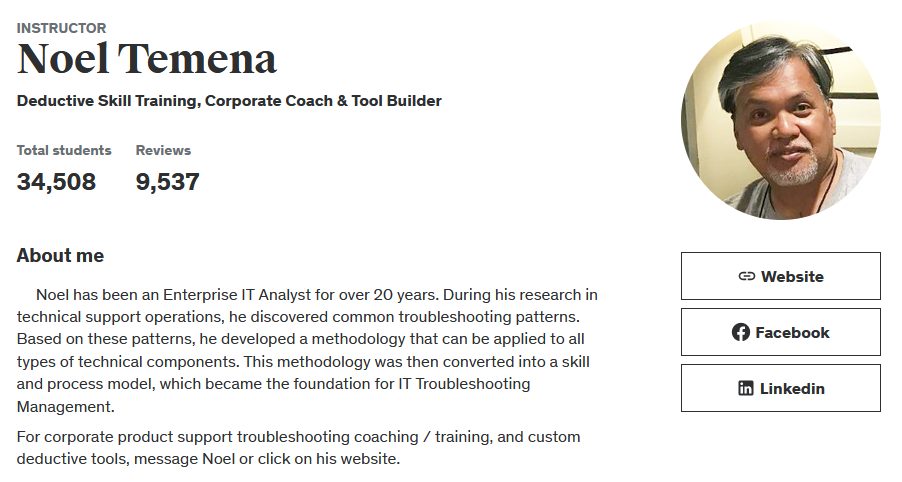Diving into the world of IT can often feel like navigating a labyrinthine puzzle. The “IT Troubleshooting Skill Training” course on Udemy, aimed at IT Analysts and Managers, presents itself as a guiding light. With an engaging mix of technique and theory, this course promises to arm its students with a toolkit for methodical problem-solving in the tech realm.
Instructor Reputation
When evaluating an online course, the instructor’s background, experience, and student feedback are paramount. Noel Temena, the guiding force behind the “IT Troubleshooting Skill Training” course on Udemy, brings a wealth of knowledge and practical expertise to the virtual classroom. With over 20 years of experience as an Enterprise IT Analyst, Noel has not only witnessed the evolution of IT support but has also played a pivotal role in shaping its practices. His journey from observing recurring troubleshooting patterns to developing a comprehensive methodology tailored for IT Troubleshooting Management exemplifies a dedication to innovation and improvement in the field.

Noel’s credentials are impressive: with an instructor rating of 4.3 based on feedback from 9,537 reviewers and having educated 34,508 students across 2 courses, his impact on the IT education landscape is undeniable. These numbers speak to his ability to connect with students, impart knowledge effectively, and address the nuanced challenges faced by IT professionals today. Moreover, his dual role as a Corporate Coach and Tool Builder highlights his commitment to not only teaching but also providing tangible tools and strategies that professionals can use to navigate their IT environments successfully.
The positive reception from his students further cements Noel’s reputation as a respected and effective instructor. Reviews often highlight his clear and engaging teaching style, the practical applicability of his methodologies, and his ability to demystify complex IT troubleshooting concepts. Students appreciate the blend of theory and hands-on exercises, emphasizing how Noel’s guidance has directly contributed to their professional growth and problem-solving skills.
In summary, Noel Temena stands out as a beacon of knowledge and expertise in the IT troubleshooting space. His extensive experience, coupled with a robust teaching methodology and positive student outcomes, underscores his effectiveness as an instructor. For anyone looking to deepen their understanding of IT troubleshooting, Noel’s course promises not just a learning opportunity but a transformative experience.
Course Structure
The “IT Troubleshooting Skill Training” course is meticulously designed to cater to a diverse audience, including IT Managers, IT Professionals, Technical Trainers, and various IT Analyst roles. The course structure is a testament to the careful consideration given to ensuring that learners at different stages of their career can derive maximum benefit. It is evident that a lot of thought has gone into organizing the content in a way that builds upon foundational concepts, gradually advancing to more sophisticated troubleshooting strategies.

The course begins with an introduction to the basic principles of IT troubleshooting, emphasizing a logic-over-rote-learning approach. This foundational stage is crucial for setting the tone of the course, as it moves away from traditional memorization tactics and towards developing a deep understanding of troubleshooting as a systematic process. Noel’s approach encourages learners to think critically about the problems they encounter and apply a methodical framework to resolve them.
As learners progress through the course, they are introduced to more complex concepts and scenarios, designed to challenge their understanding and encourage the application of the principles learned in earlier modules. This includes technical deduction and fault isolation exercises that are central to effective troubleshooting. Through these exercises, the course aims to condition the learners’ “technical reflexes,” enhancing their ability to quickly and efficiently identify and solve IT issues.
An innovative aspect of the course structure is its emphasis on repetitive exercises and drills. This pedagogical choice reinforces learning through practice, ensuring that concepts are not only understood but also readily applicable in real-world scenarios. The course also includes content downloads, lists of useful tools, and resources that further support the learning process, allowing students to engage with the material beyond the confines of the virtual classroom.
Feedback from students has highlighted areas for improvement, particularly in the early sections of the course where a desire for deeper technical detail and more polished presentation materials was expressed. Nonetheless, the overall structure of the course—with its blend of theory, practical exercises, and supplemental resources—has been well-received for its comprehensiveness and focus on developing actionable troubleshooting skills.
In conclusion, this course offers a well-rounded and strategically organized learning experience. Its structure is designed to cater to a wide range of learners, from those seeking to build a solid foundation in IT troubleshooting to seasoned professionals looking to refine their skills. Noel Temena’s expertise and the course’s focus on a methodical, principle-based approach make it a valuable resource for anyone in the IT field.
Content Quality
The “IT Troubleshooting Skill Training” course distinguishes itself through its high-quality content, which is both comprehensive and engaging. The course material is carefully curated to cover a wide array of troubleshooting scenarios, ensuring that learners gain a broad understanding of IT issues and how to approach them effectively. One of the standout features of this course is its focus on developing troubleshooting intelligence, which is fostered through a combination of theoretical instruction and practical exercises.

The theoretical component of the course lays a solid foundation, offering insights into the principles of troubleshooting that are applicable across various technologies and platforms. This is not about memorizing solutions to specific problems but about understanding the underlying logic that guides the troubleshooting process. By prioritizing this approach, Noel Temena ensures that learners are equipped with the skills needed to tackle new and unforeseen challenges, a critical ability in the ever-evolving IT landscape.
On the practical side, the course excels in providing learners with hands-on exercises and drills designed to simulate real-world troubleshooting scenarios. These activities are integral to the learning experience, allowing students to apply theoretical concepts in practice and refine their problem-solving strategies. The emphasis on technical deduction and fault isolation exercises is particularly valuable, as these are key skills for any IT professional. Through repetitive practice, students develop quicker, more effective troubleshooting reflexes, enhancing their overall performance in their respective roles.
Despite these strengths, some students have pointed out areas for improvement, particularly regarding the early content’s breadth and the presentation quality of course materials. These critiques suggest that while the foundational concepts are strong, a deeper dive into technical specifics and more polished materials could enhance the learning experience. Nevertheless, the course’s inclusion of downloadable content, useful tools, and resources adds significant value, providing learners with additional means to engage with and understand the material.
Overall, the content quality of the “IT Troubleshooting Skill Training” course is commendable. It successfully balances theory and practice, providing learners with a comprehensive toolkit for effective IT troubleshooting. The course’s focus on developing a methodical, logical approach to problem-solving is its greatest strength, preparing students to face a wide range of IT challenges with confidence and skill.
Overall Course Rating – 8.5/10
After thoroughly reviewing the “IT Troubleshooting Skill Training” course, including its structure, content, and instructor reputation, it’s time to provide an overall course rating. Taking into account the depth and breadth of the course content, the expertise and teaching style of instructor Noel Temena, and the feedback from students, the course earns an 8.5 out of 10.

Pros:
- Noel Temena’s extensive experience and effective teaching methodology greatly enrich the learning experience.
- The course’s emphasis on a logical, principle-based approach to troubleshooting equips learners with versatile and durable skills.
- Practical exercises and drills are thoughtfully designed to simulate real-world scenarios, fostering technical deduction and fault isolation skills.
- Additional resources, including downloadable content and lists of tools, provide valuable support for learners.
Cons:
- Early sections of the course may benefit from more detailed technical content and deeper dives into specific troubleshooting scenarios.
- The presentation and formatting of course materials could be improved for clarity and engagement, as suggested by some student feedback.
Student Feedback Highlights:
- Positive remarks focus on the course’s clear structure, practical exercises, and Noel’s engaging teaching style.
- Constructive criticisms and suggestions for improvement, including calls for more detailed technical content and polished presentations.
In conclusion, this course stands out as a valuable resource for IT professionals seeking to enhance their troubleshooting skills. Noel Temena’s expertise and the comprehensive course structure provide a solid foundation for learners. While there is room for improvement in content depth and presentation, the course’s strengths in fostering practical, applicable skills make it a commendable choice for anyone looking to improve their IT troubleshooting capabilities. With an overall rating of 8.5 out of 10, this course is well-positioned to help IT professionals, from managers to analysts, navigate the complexities of troubleshooting in the modern tech environment.



